For many people who worked a desk job before the pandemic, a typical workday involved a whopping 40+ hours of sitting at a desk—broken up with the occasional coffee run, power walk to lunch, or even a sprint to your next meeting. Now enter COVID-19.
You’re probably still sitting in front of your desk, but now at home—and for longer periods of time. With remote work here to stay for a while, new health risks are—unfortunately—a concern.
Experts expect to see an increase in sedentary behavior because of the COVID-19 pandemic, and living a sedentary lifestyle can increase your risk of chronic conditions like heart disease, which is the leading cause of death for both men and women in the United States.
So, how can you stay healthy while working from home? Read on or skip to our infographic to discover 8 simple heart healthy desk exercises that can strengthen both your heart and body while you work.
What Types of Exercises Improve Heart Health?
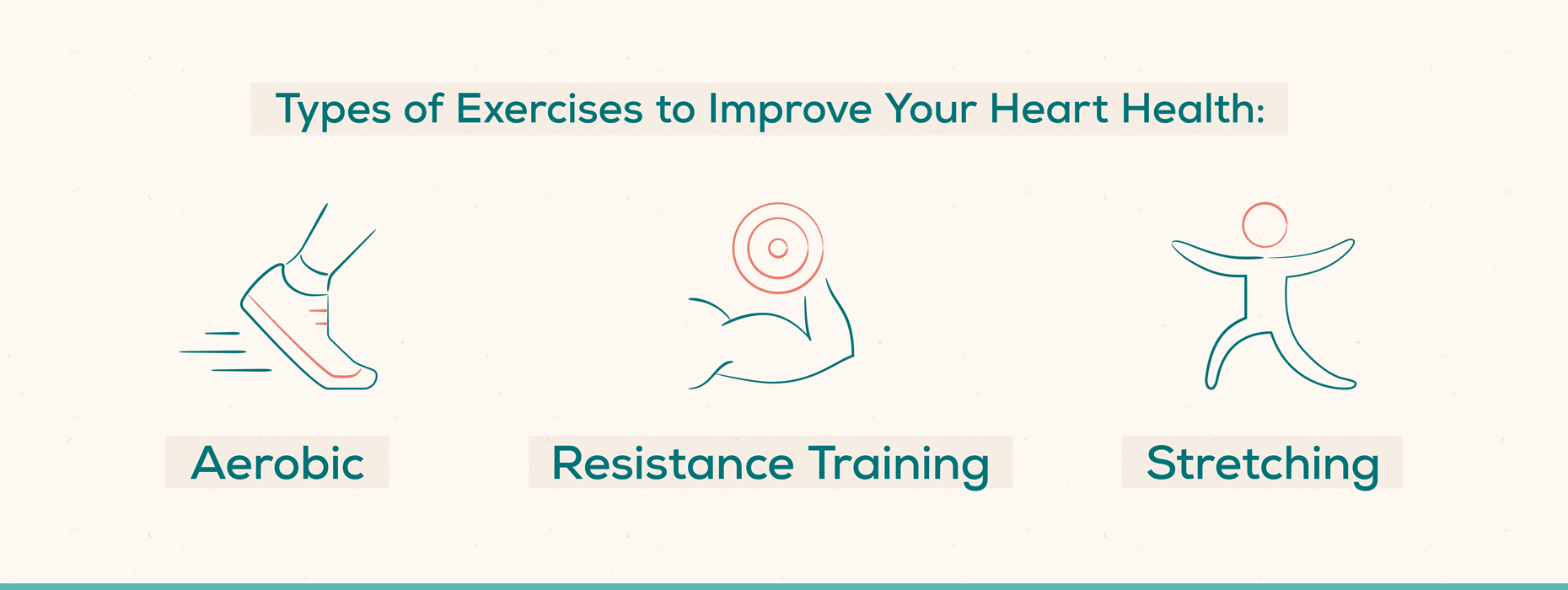
There are several benefits to living an active lifestyle. For instance, being active can help improve how you think, feel, and sleep, plus it can allow you to perform daily tasks more easily. If you’ve found yourself more sedentary in your work-from-home routine, the first step to reduce your risk of heart disease is to sit less and move more.
While there are several ways to move your body, we’ve listed the most important types to improve your heart health below. Keep in mind that it’s always recommended to speak with your healthcare provider before committing to an increase in physical activity.
Aerobic
By definition, aerobic means “requiring oxygen.” Aerobic exercises are a type of cardiovascular (or “cardio”) conditioning aimed to increase your breathing and heart rate. This could include activities like brisk walking, jump roping, running, dancing, or cycling. Since aerobic exercise improves circulation, the result is a lowered blood pressure and heart rate, improving your overall heart health.
The Department of Health and Human Services (DHHS) Physical Activity Guidelines recommend that adults do at least 150–300 minutes a week of moderate-intensity or 75–150 minutes a week of vigorous-intensity aerobic exercise. To help differentiate between the two, think of moderate-intensity as exercise you are able to talk through while doing it, and vigorous-intensity exercise as activity where you will not be able to say more than a few words without pausing for a breath.
Stretching
Basic stretching is targeted at improving flexibility, which can benefit your musculoskeletal health, allowing you to do and recover from the exercises that improve your heart. Stretching also helps you maintain your balance, and can limit your risk of injury when exercising.
Ideally, you should stretch every day both before and after exercising.
Resistance Training
Resistance training is any exercise that causes your muscles to contract to increase your strength or endurance. With resistance training, you can use weights, resistance bands, or your own body weight to build muscle. While it can help you build muscle, resistance work in combination with aerobic exercise may also raise HDL (good) cholesterol and lower LDL (bad) cholesterol, which can reduce your risk of heart disease.
The Department of Health and Human Services (DHHS) Physical Activity Guidelines recommend that adults perform muscle-strengthening activities two or more days a week; however, it’s important to let your muscles recover for a day or two between sessions.
Heart Healthy Desk Exercises
1. Neck Stretch
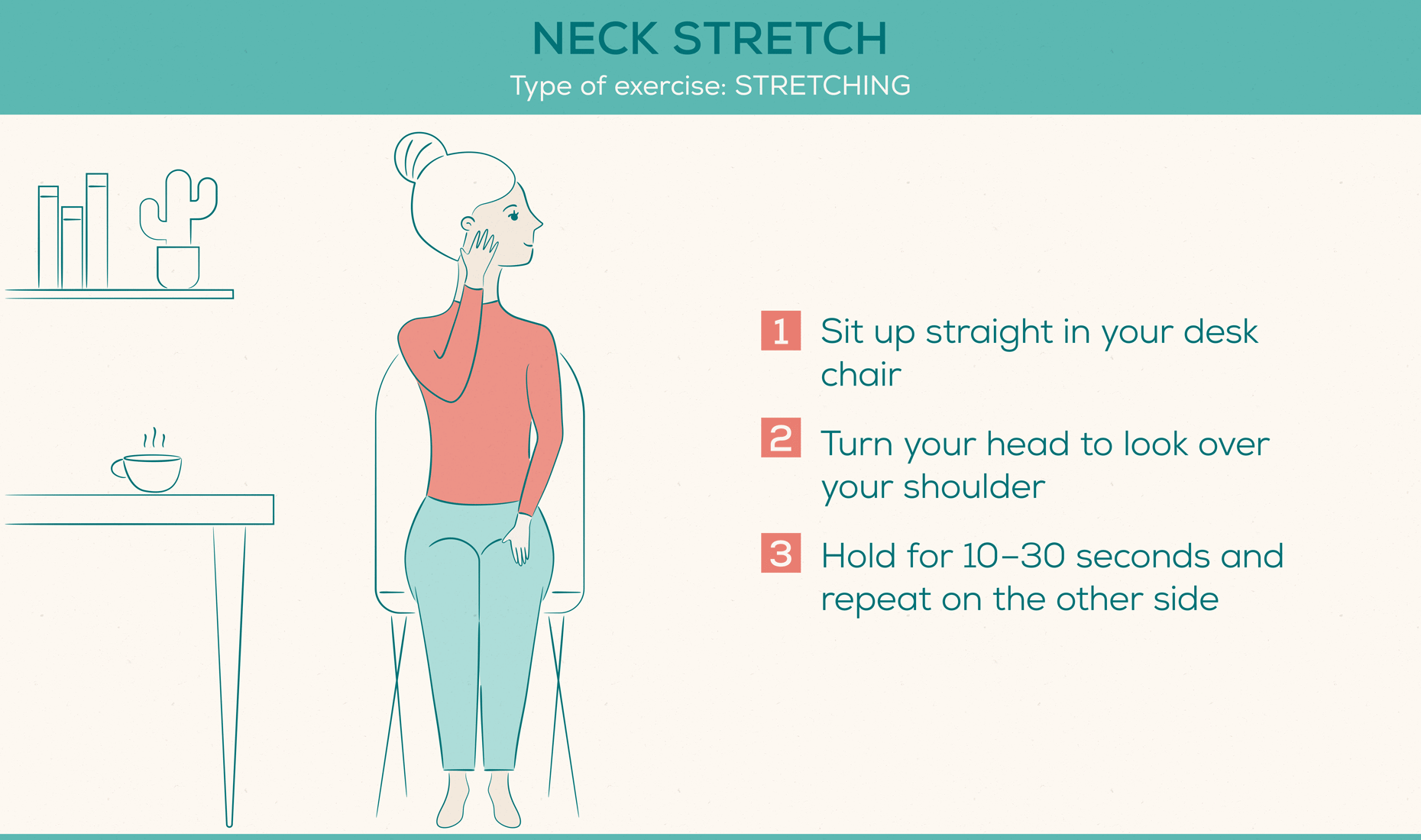
Type of heart healthy exercise: Stretching
Additional benefits: This exercise can maintain or improve the range of motion in your neck and may relieve some of the stiffness you may experience from sitting all day or having poor posture.
How to do it: A neck stretch is a great exercise to do while you work. While keeping your back against your desk chair, simply turn your head to look over your shoulder. Hold this position for 10–30 seconds and repeat on the other side.
Duration: 6–8 times on each side x2
2. Desk Dips

Type of heart healthy exercise: Resistance training
Additional benefits: This exercise engages the tricep muscles and core.
How to do it: As the name suggests, a desk dip (or a tricep dip) can be done using a secure, stable desk. To do this, place both of your hands facing forward on the edge of your desk. Keep your palms flat on the desk and bend your elbow straight back into a 90-degree angle. Lower yourself up and down by bending and straightening your elbows.
Duration: Complete 20 dips
3. Torso Twist
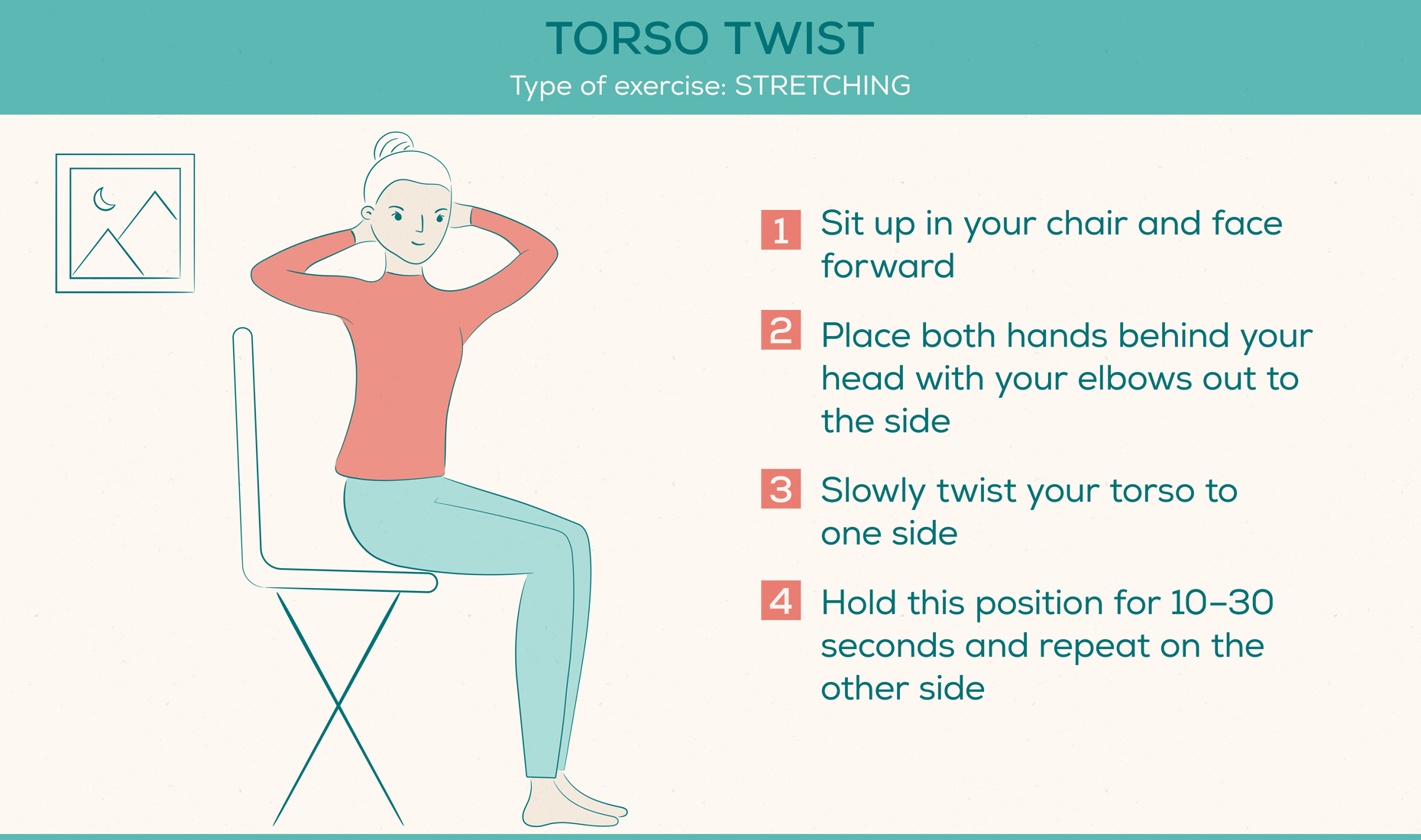
Type of heart healthy exercise: Stretching
Additional benefits: This exercise can maintain or improve the range of motion in your torso and activates your core muscles which help stabilize your spine.
How to do it: While sitting up and facing forward in your desk chair, place both hands behind your head with your elbows out to the side. Keep your head and hands in place then slowly twist your body to one side so you face the side wall. Make sure you are twisting from your waist without moving your hips. Hold this position for 10–30 seconds and repeat on the other side.
Duration: Hold the position for 10-30 seconds. Perform this movement 6–8 times on each side. Rest, then do a second set.
4. Leg Raises

Type of heart healthy exercise: Resistance training
Additional benefits: This exercise targets your quadriceps (front of your thighs), hamstrings, and glutes.
How to do it: With leg raises you can get a great workout without ever getting up. Sit upright in your desk chair, facing forward. Straighten out your legs so that they’re parallel to the floor and hold them in place for 10 seconds. Repeat.
Duration: Hold position for 10 seconds, repeat 15 times.
5. Chair Squats

Type of heart healthy exercise: Resistance training
Additional benefits: This exercise targets your quadriceps (front of your thighs), hamstrings, glutes, and core muscles.
How to do it: This is a simple exercise that targets your lower body. To do this, stand up from your chair and take a step or two forward. Stand up straight, keep your weight in your heels, then lower your body back down, stopping right before you sit.
Duration: Repeat 10 times. Then try another set.
6. Desk push-ups

Type of heart healthy exercise: Resistance training
Additional benefits: This exercise targets your chest, shoulders, triceps, and core.
How to do it: First, make sure your desk is sturdy enough to hold your body weight. Then, take a few steps back and put both palms flat on the front of your desk, while making sure they are shoulder-width apart. Lower yourself toward your desk and then push back up.
Duration: Try to complete 20 push-ups.
7. Jumping Jacks
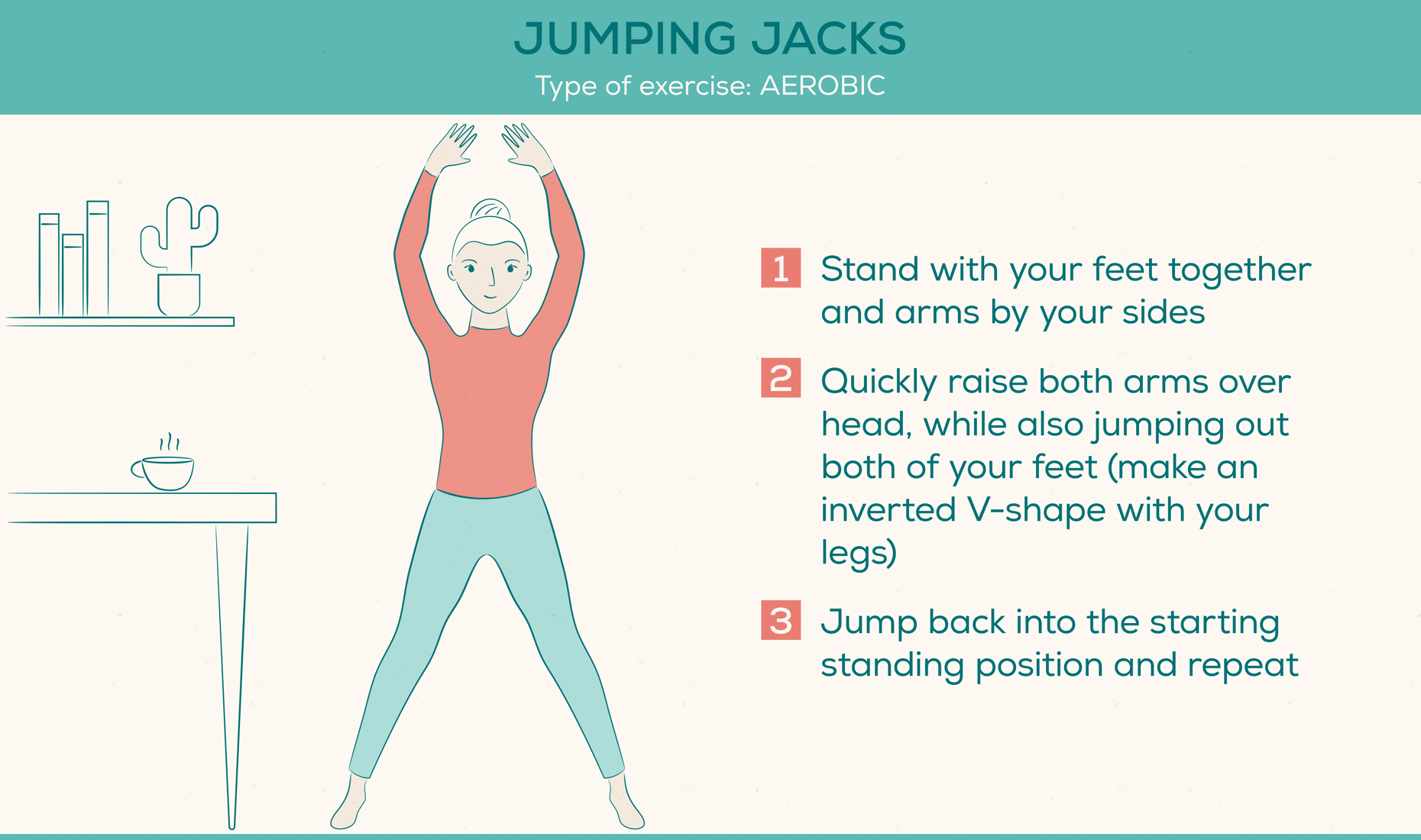
Type of heart healthy exercise: Aerobic
Additional benefits: This exercise and other aerobic exercises promote increased circulation and when performed regularly, can help lower blood pressure.
How to do it: Start by standing straight with your feet together and arms by your sides. Then quickly raise both arms overhead while also jumping both of your feet out to the side, making an inverted V-shape with your legs. Jump back into the starting position and repeat.
Duration: 30 jumping jacks
8. Lunges
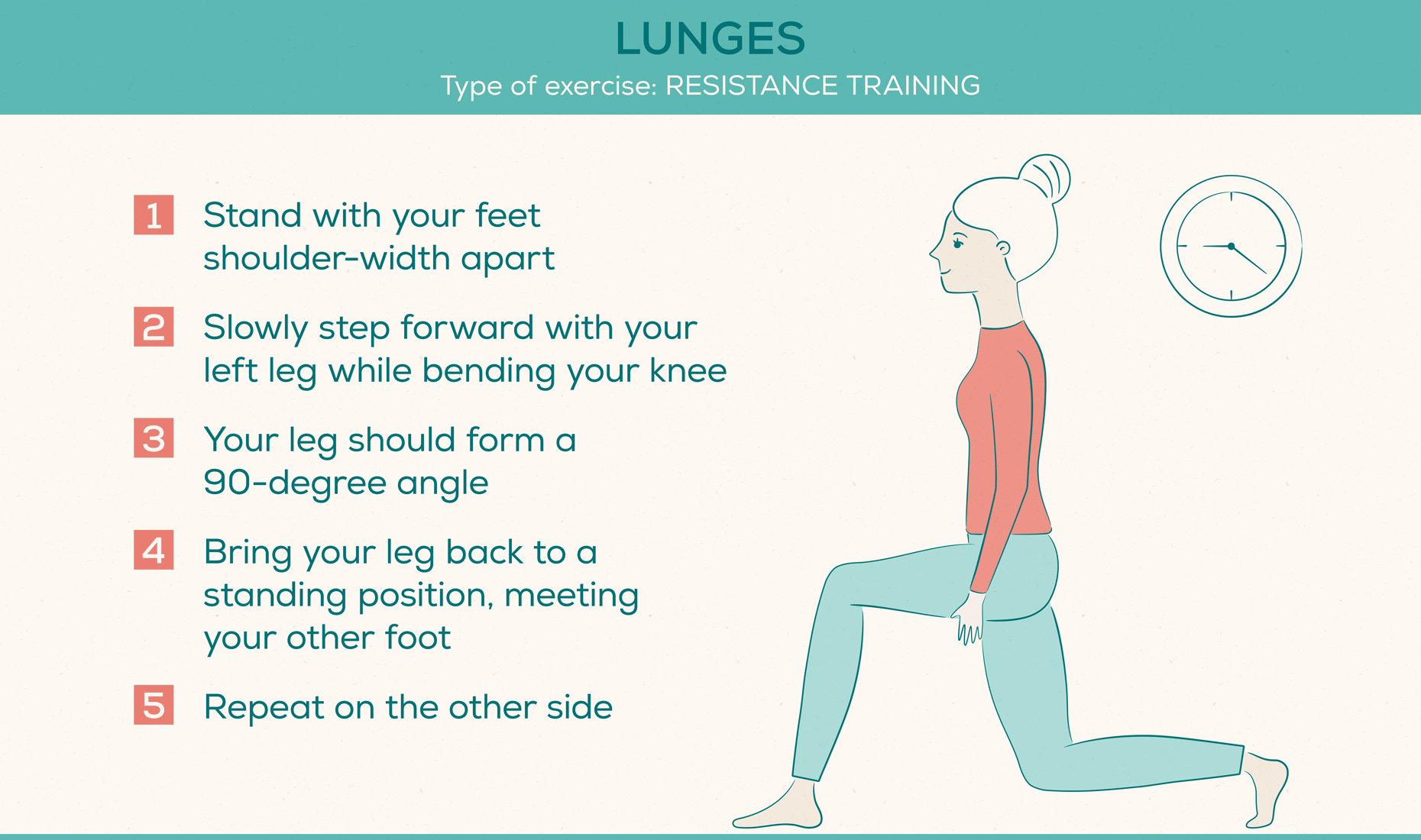
Type of heart healthy exercise: Resistance training
Additional benefits: This exercise targets your abdominals, lower back, glutes, quadriceps, hamstrings, and calves.
How to do it: For this exercise you’ll have to find a spot next to your desk where there is enough space to move. Then, stand with your feet shoulder-width apart and slowly step forward with your left leg while bending your knee. Your left leg should form a 90-degree angle. Then slowly bring your left leg back to a standing position, meeting your right foot. Repeat on the right side.
Duration: 5–15 reps, then switch legs
Ways to Keep Your Heart Healthy

Everyone is at risk of heart disease, and in the U.S., 1 in 4 deaths are attributed to heart disease each year. Luckily, in addition to keeping your heart healthy by staying active, there are a few things that you can do to mitigate your risk of developing heart disease.
- Eat healthily
- Sit less and move more
- Maintain a healthy weight
- Quit smoking and stay away from secondhand smoke
- Control your cholesterol and blood pressure
- Drink alcohol only in moderation
- Manage Stress
- Regularly measure your cholesterol levels
Approximately 80% of US adults and adolescents are insufficiently active, and gym closures, remote working, and stay at home orders due to the COVID-19 pandemic are only making it more difficult to keep your body moving. Staying active from home can be a challenge, but it’s definitely possible. And if you have any concerns about your heart health, consider taking an at-home heart health test or cholesterol and lipids test to monitor your health and risk of chronic heart conditions.
Sources: CDC | American Heart Association | John Hopkins Medicine | JAMA Network | National Center for Biotechnology Information, U.S. National Library of Medicine












